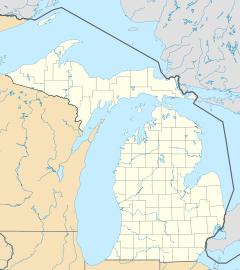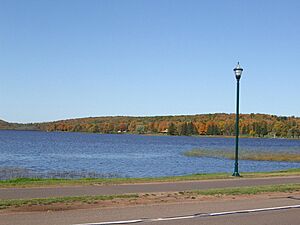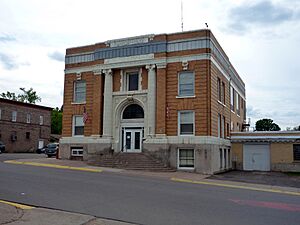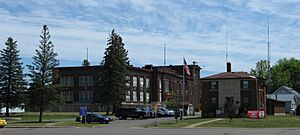Wakefield, Michigan facts for kids
Quick facts for kids
Wakefield, Michigan
|
|
|---|---|
| City of Wakefield | |
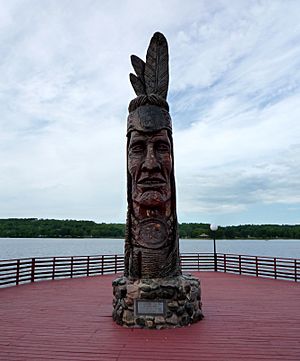
Nee-Gaw-Nee-Gaw-Bow (Leading Man), a statue honoring the Ojibwe people. It's one of Peter Wolf Toth's "Whispering Giants."
|
|
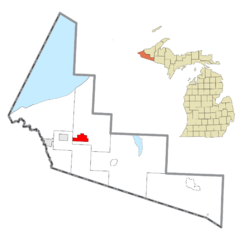
Location within Gogebic County
|
|
| Country | United States |
| State | Michigan |
| County | Gogebic |
| Incorporated | 1887 (village) 1919 (city) |
| Government | |
| • Type | Council–manager |
| Area | |
| • Total | 8.44 sq mi (21.85 km2) |
| • Land | 7.87 sq mi (20.39 km2) |
| • Water | 0.57 sq mi (1.47 km2) |
| Elevation | 1,539 ft (469 m) |
| Population
(2020)
|
|
| • Total | 1,702 |
| • Density | 216.21/sq mi (83.47/km2) |
| Time zone | UTC-6 (Central (CST)) |
| • Summer (DST) | UTC-5 (CDT) |
| ZIP code(s) |
49968
|
| Area code(s) | 906 |
| FIPS code | 26-82780 |
| GNIS feature ID | 1622046 |
Wakefield is a city in Gogebic County, Michigan. In 2020, about 1,702 people lived there.
Wakefield is in the western Upper Peninsula. It is about 10 miles (16 km) east of the Wisconsin border. The city is mostly surrounded by Wakefield Township. However, the city and township are run separately. U.S. Route 2 goes through the city. M-28 starts here.
The city is home to Sunday Lake and Snow River Mountain Resort. It also has the Gogebic County Medical Care Facility. Wakefield was once a mining town. Today, its economy relies on the forest industry, local businesses, and tourism.
Contents
History of Wakefield
How Wakefield Started
George Mix Wakefield was born in New York in 1839. He planned the town of Wakefield in May 1886. People had already been calling the area "Wakefield" since 1884.
George M. Wakefield's family moved to Wisconsin in 1844. He became interested in logging and buying land. He bought large areas of land in Michigan's western Upper Peninsula in the 1870s and 1880s. He built sawmills and cut down pine trees. Later, he looked for minerals. He owned parts of the Sunday Lake mine and other mines nearby.
George M. Wakefield's Businesses
Mr. Wakefield moved to Milwaukee, Wisconsin in 1879. He started a business that bought and sold land with timber and minerals. This land was in Michigan, Wisconsin, Texas, and Alaska.
He helped create the Ontonagon River Improvement and Boom Company in 1880. This company made it possible to float logs to Lake Superior. They also built a sawmill near the mouth of the Ontonagon River.
In 1899, the G. M. Wakefield Mineral Land Company was formed. It dealt with land for minerals, timber, and farming. George M. Wakefield and his family owned this company.
Becoming a Village and City
Wakefield officially became a village on November 20, 1887. It became a city in 1919.
The Mining Boom Years
Wakefield grew because iron ore was found on the east side of Sunday Lake in 1881. After this discovery, many mining companies came to the area. Many mines opened. Villages like Plymouth and Castile were named after these iron mines.
The first mines in Wakefield were the Sunday Lake, Iron Chief, and Brotherton mines. In 1886, these mines produced thousands of tons of iron.
Here are some of Wakefield's iron mines:
- MIKADO: This mine shipped over one million tons of ore from 1895 to 1917.
- PILGRIM: This mine shipped twenty-two thousand tons from 1919 to 1927.
- PLYMOUTH: This was an open-pit mine that shipped almost seventeen million tons. It closed in 1952.
- WAKEFIELD: This mine started shipping ore in 1913. It became an open-pit mine and shipped almost fourteen million tons. It closed in 1954.
- CITY OF CHICAGO: This mine produced almost one hundred thousand tons of ore between 1896 and 1915.
- SPARTA: This mine shipped almost ten thousand tons from 1891 to 1895.
- ALPHA: This mine was taken over by the PIKE mine by 1890.
- PIKE: This mine shipped over one hundred five thousand tons from 1899 to 1910.
- BROTHERTON: This mine shipped over two million six hundred ninety thousand tons. It closed in 1923.
- SUNDAY LAKE: This mine was first explored in 1881. It shipped over seventeen million tons of ore. It closed on February 16, 1961.
- IRON CHIEF: This mine shipped about twelve thousand tons of iron ore in 1886 and 1887.
- CASTILE: This mine produced almost nine hundred thousand tons of ore. It closed in 1923.
- METEOR: This mine shipped one hundred thirty-two thousand tons between 1899 and 1904.
- COMET: This mine shipped eighty-nine thousand tons from 1890 to 1893.
- MORGAN: This mine shipped over fifty-eight thousand tons from 1923 to 1925.
- VICAR: This mine shipped about one hundred two thousand tons in 1950–1951.
Life After Mining
After the Sunday Lake Mine closed in 1961, Wakefield's economy changed. It moved from mining to the forest industry, local businesses, and tourism.
Logging has been important to the local economy since the early 1900s. The county started a forest project in 1941. This project showed that forests could last and grow in value with careful cutting. Many successful logging and lumber businesses have been in Wakefield. They support larger lumber and plywood mills nearby.
When mining jobs were lost, many people started businesses. These included restaurants, food markets, and gas stations. These businesses help meet the needs of the community.
Tourism and Fun Activities
Wakefield gets a lot of snow, usually 156 to 240 inches (400 to 610 cm) each year. This helps winter tourism. Indianhead Mountain opened in 1959. It is now a big attraction in both winter and summer.
Many tourists come for:
- Snowmobile trails
- Cross-country skiing trails
- Ice fishing on Sunday Lake
In the summer, people enjoy:
- Hiking
- Camping
- Fishing
- American Power Boat Association (APBA) boat races on Sunday Lake
Many people also return for the annual July 4 celebration. This week-long event includes:
- Softball tournaments
- High school class reunions
- A town picnic and concert at Eddy Park
- A Sunday Lake run contest
- A Main Street parade
- Children's races
- Fireworks over Sunday Lake
2016 Storm Event
Strong storms hit the Gogebic Range on July 11-12, 2016. The storm caused flash floods. Wakefield was hit by a thunderstorm with winds around 90 mph (145 km/h). Many trees and power lines fell. A camper trailer was overturned, and the roof of an old ice rink was torn off. Parts of the city were without power for a long time.
Population Changes
| Historical population | |||
|---|---|---|---|
| Census | Pop. | %± | |
| 1900 | 1,191 | — | |
| 1910 | 714 | −40.1% | |
| 1920 | 4,151 | 481.4% | |
| 1930 | 3,677 | −11.4% | |
| 1940 | 3,591 | −2.3% | |
| 1950 | 3,344 | −6.9% | |
| 1960 | 3,231 | −3.4% | |
| 1970 | 2,757 | −14.7% | |
| 1980 | 2,591 | −6.0% | |
| 1990 | 2,318 | −10.5% | |
| 2000 | 2,085 | −10.1% | |
| 2010 | 1,851 | −11.2% | |
| 2020 | 1,702 | −8.0% | |
| U.S. Decennial Census | |||
Population in 2010
In 2010, Wakefield had 1,851 people. There were 818 households. About 96.8% of the people were White. About 1.1% were Native American.
- 17.1% of residents were under 18 years old.
- 26.7% were 65 years or older.
- The average age was 50.1 years.
Historical Population Numbers
The population was highest in 1920 during the mining boom. It has slowly decreased since then.
| 1887 | 1888 | 1891 | 1893 | 1897 | 1901 | 1903 | 1905 | 1909 | 1910 |
|---|---|---|---|---|---|---|---|---|---|
| 300 | 2,320 | 1,000 | 700 | 407 | 1,191 | 1,000 | 1,500 | 1,300 | 700 |
| 1920 | 1930 | 1940 | 1950 | 1960 | 1970 | 1980 | 1990 | 2000 | 2010 |
| 4,151 | 3,677 | 3,591 | 3,367 | 3,231 | 2,757 | 2,591 | 2,318 | 2,085 | 1,851 |
Community Life
City Hall and Government
The City Hall is now located at 509 Sunday Lake Street. It used to be in an older building. In 2014, the city moved to the Father Daniel Hall because the old building needed many repairs and did not meet modern standards. The new building is easier for everyone to access. The city bought this new building in 2015.
The City Council includes the Mayor, Mayor Pro Tem, and three council members. They are elected for two-year terms.
City Projects
Some current projects in Wakefield include:
- A walking trail and lights along Sunday Lake.
- New playground equipment at Eddy Park.
- The demolition of the old Memorial Building.
- A Renaissance Tax-Free Zone. This zone helps bring new jobs and businesses to the area by offering tax benefits.
Memorial Building History
The Wakefield Memorial Building was finished in 1924. It was a big community center. It cost $400,000 and was built to honor young people who fought in World War I. It had:
- A banquet area
- Meeting rooms
- An olympic size swimming pool
- A movie theater with 1,200 seats
After the local iron mines closed in the late 1950s, the city lost money. It could no longer afford to run the Memorial Building. Over time, the building fell apart. The roof was destroyed by harsh winters.
In 2004, Marvin Suomi bought the building. A group was formed to build a new, smaller community center. The old building was torn down in 2010. Twelve stained-glass windows from the old theater were saved. The new building plans include city offices, a library, and a swimming pool.
Education in Wakefield
- The Wakefield-Marenisco School is on the southeast shore of Sunday Lake. The first school building was built in 1890.
- In 2004-2005, the Wakefield and Marenisco school districts joined together. The combined schools have about 300 students.
- Central School Elementary closed in 2000. Its students moved to the high school building.
- The Mary McDonald School was built in 1909 and torn down in 1974.
Wakefield Public Library
The Wakefield Public Library opened on February 4, 1935. It was first on the second floor of the old City Hall. Now, it is at 401 Hancock Street. The library serves both the City and Township of Wakefield. With help from "Friends of the Library," it has been updated. The children's section was remodeled in 2005, and the teen section in 2006.
Healthcare and Senior Living
- Gogebic County Medical Care Facility is a 109-bed Nursing Home. It provides care for seniors with different needs.
- Gogebic County Community Mental Health Authority helps people with emotional or mental health needs.
- KeenAgers Corporation offers assisted living and independent living for older adults.
- Sunset Manor provides independent living for elderly and low-income residents.
Places of Worship
- Grace Baptist Church
- Immaculate Conception Catholic Church
- All Saints Lutheran Church
- Wakefield Methodist Church
- Calvary Baptist Church
Community Groups
- Wakefield Senior Citizen Center: Offers programs on healthcare and nutrition for seniors. It also helps with the Meals on Wheels program.
- Rotary Club of Bessemer and Wakefield: Meets weekly.
- Wakefield Historical Society: Collects items from the past, especially about mining and lumbering.
- Veterans of Foreign Wars Post 9084
- American Legion Post 11
Recreation and Tourism Spots
- Eddy Park & Campground: Located on Sunday Lake. It has picnic areas, a playground, and swimming. The campground has water, electricity, and sewer services.
- Indianhead Mountain Ski Resort: West of the city. It has a vertical drop of 638 feet (194 m) and 29 ski runs. In summer, people hike, golf, and watch wildlife.
- American Power Boat Association (APBA) boat races: Wakefield has hosted these races on Sunday Lake several times.
Local Media
- The Wakefield News-Bessemer Pick & Axe: A weekly newspaper.
- The Ironwood Daily Globe: Published Monday through Saturday.
- Radio stations: WJMS AM 590, WIMI FM 99.7, and WUPM FM 106.9.
Famous People from Wakefield
- Walter S. Goodland: A former Governor of Wisconsin who practiced law here.
- Ernest J. Korpela: A Wisconsin State Assemblyman born in Wakefield.
- Betty Ren Wright: An award-winning writer of children’s fiction born in Wakefield.
Getting Around Wakefield
Main Roads
 US 2
US 2 M-28
M-28 CR 519
CR 519
Bus Service
- Indian Trails provides daily bus service connecting Wakefield to other towns.
Trails
- State Line Trail
Books About Wakefield
- Cox, Bruce K., Pioneers of Wakefield Michigan 1884–1900, Agogeebic Press, LLC, 2007.
- Cox, Bruce K., Headframes and Mine Shafts of the Gogebic Range, Volume 2, Bessemer-Ramsay-Wakefield, Agogeebic Press, LLC, 2000.
|
See also
 In Spanish: Wakefield (Míchigan) para niños
In Spanish: Wakefield (Míchigan) para niños


